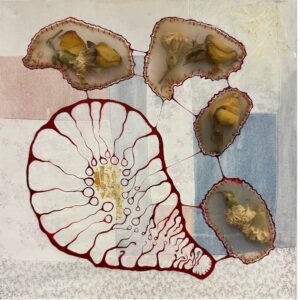Piper Snowber
Womb
Canvas, rose petals, acrylic, oil paint, nylon mesh
12” x 12”
upon pondering death, dying, and all that will turn to rubble: fertility, restraint, sanctity, and the female body a flower. a womb-like form came to me as it would when looking at the grave of a mother or a shriveled carcass of underneath the wombs lies a quilt whose seams are tested in an unfamiliar way: over the lips of a wooden frame. perhaps this tension is a question; a question of the structural integrity of the form itself, a question of the weight of the womb it holds. perhaps the tension is a landscape: physical; political. quilts beg the questions of where we come from, what we carry with us, and what we swaddle ourselves with as disease and disaster and anger and violence and blood and dirt and stone smack us in the face as we emerge into the world. quilts beg the action of returning home: the womb. the tension between the female body and the world that brushes up against it: the tension between bodies pushing against one another in the womb. suffocation, or breathing, or whatever it is that happens in the womb: a war or a beautiful blooming? life is created, life is simultaneously destroyed, in every corner of the universe. the flowers touch on themes of forced containment of life, birth, and death in our society: the disconnection and sanitization of these natural processes, how the body is confined by human-made constructs (such as pantyhose), and how the body dies in conditions such as these, or despite of these. consider how desperately and inextricably intertwined the body is with the womb and the natural world, no matter how far the distance, of time or of the physical. consider how we are ripped from these things. the flower as a body and the flower as a withering of the body, a concept and a parallel to the fragility of human life and mother earth. in the mortal conscience we yearn for the womb-state: pre-life and pre-death. yet we still grow like flowers and we still die like flowers; we shrink and disintegrate and our colors change as we try to hold our bodies together; we wish someone could do it for us: we wish to be held once again by the womb. the tension between what we wish for and what will never be is a life-long war we accept. to weep in a mother’s arms. to re-enter the womb. to bleed sap. to be held up by what was held down. these tensions could kill us, these tensions could set us free.

